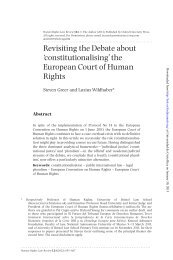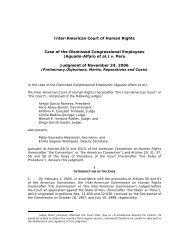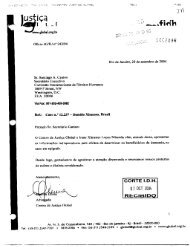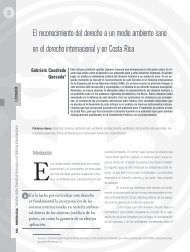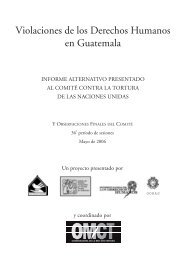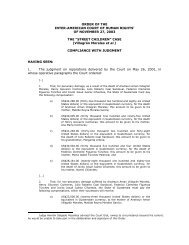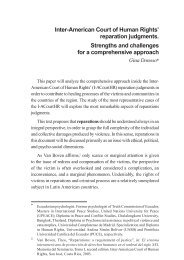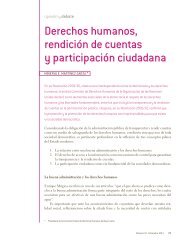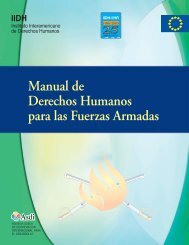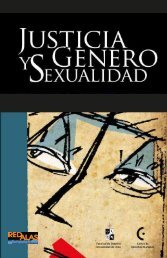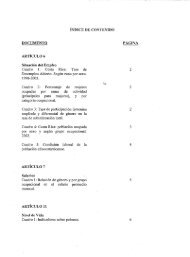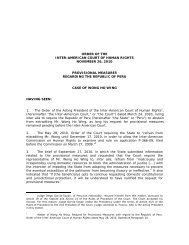Escrito de solicitudes, argumentos y pruebas presentado por la ...
Escrito de solicitudes, argumentos y pruebas presentado por la ...
Escrito de solicitudes, argumentos y pruebas presentado por la ...
Create successful ePaper yourself
Turn your PDF publications into a flip-book with our unique Google optimized e-Paper software.
001426<br />
On 14 April about 100 police, un<strong>de</strong>r the command of Colonel Cajahuanca himself,<br />
entered our prison blocks in the presence of a <strong>de</strong>legate from the International Red Cross,<br />
public prosecutors from the police <strong>de</strong>partment only, since it was maintained that they<br />
had been unable to obtain the services of any civilian prosecutors. They were<br />
accompanied by officers from the police, the army and the navy, dressed in civilian<br />
clothes This is a known fact, since comments frorn war<strong>de</strong>rs and common prisoners<br />
confirm that these officers were known to thern. For more than two hours they ma<strong>de</strong> a<br />
thorough search of all our quarters, of the walls, roofs and ducts, etc. When this<br />
inspection was over, at our insistence, an official document was drafted and signed In<br />
the said document it is expressly admitted that there were no arms, tunnels 01' any<br />
evi<strong>de</strong>nce of p<strong>la</strong>ns to escape. It is also confirmed that everything was proceeding with<br />
absolute normality Furthermore, it was stated that the police could go into our blocks<br />
to cauy out the so-called "head count" without any problems.r"<br />
Como lo han seña<strong>la</strong>do diversos testigos <strong>la</strong> inspección <strong>de</strong>l 14 <strong>de</strong> abril fue exhaustiva.i" Como<br />
lo corrobora el <strong>de</strong>legado Camilo Baras, todas <strong>la</strong>s celdas y áreas <strong>de</strong> los pabellones fueron<br />
meticulosamente inspeccionados <strong>por</strong> <strong>la</strong> policía. Esto incluía <strong>la</strong> revisión <strong>de</strong> sus ropas, efectos<br />
personales, frazadas, utensilios <strong>de</strong> limpieza, colchones (los cuales a veces eran abiertos con<br />
un cuchillo para chequear que no hubieran objetos escondidos <strong>de</strong>ntro <strong>de</strong> ellos)JJ7, inspección<br />
<strong>de</strong> pare<strong>de</strong>s y toda área posible don<strong>de</strong> objetos prohibidos pudieran se escondidos Como<br />
Baras lo atestiguó:<br />
[ ... ] rompían <strong>la</strong>s fundas <strong>de</strong> los colchones y <strong>la</strong>s abrían <strong>por</strong> los costados, golpeaban <strong>la</strong>s<br />
pare<strong>de</strong>s, el piso y el techo para verificar que no haya huecos, Así hacían con cada uno<br />
<strong>de</strong> los ambientes en los 4 pisos. JJ8<br />
Por tanto, en aquel<strong>la</strong> ocasión <strong>la</strong> policía revisó en primer lugar cada piso <strong>de</strong>l pabellón 4B.<br />
Como fuera notado con anterioridad en este escrito, cada piso consistía <strong>de</strong> 16 celdas (cada<br />
celda medía aproximadamente 1.80 <strong>de</strong> ancho <strong>por</strong> 2 metros <strong>de</strong> <strong>la</strong>rgo) y un área que medía el<br />
doble <strong>de</strong> una celda <strong>la</strong> cual había sido originalmente diseñada para ser el tópico (enfermería)<br />
en cada piso (<strong>la</strong> cual medía 3 y medio metros <strong>de</strong> ancho <strong>por</strong> 3 metros <strong>de</strong> <strong>la</strong>rgo), Por tanto, <strong>la</strong><br />
policía revisó 17 diferentes áreas <strong>de</strong> cada piso más el área <strong>de</strong> <strong>la</strong>s cabinas, La policía también<br />
inspeccionó el área <strong>de</strong> <strong>la</strong> cocina <strong>de</strong>ntro <strong>de</strong>l pabellón. La inspección allí incluyó un cuidadoso<br />
chequeo <strong>de</strong>l horno para panificación pues los prisioneros hacían su propio pan. También<br />
hubo una inspección <strong>de</strong>l patio, los baños localizados en el patio, y el área adyacente al patio<br />
conocida como "Tierra <strong>de</strong> Nadie", el cual consistía <strong>de</strong> un tragaluz, el cual era usado <strong>por</strong> los<br />
prisioneros como huerto para producir sus vegetales y que contenía a<strong>de</strong>más algunos<br />
COlIa1 ItOS , con aruma . liItOS en elIos, J39<br />
335 Testimony 01 Osmán Morote Barrionuevo (Exhibil 236)<br />
336 On the same poinl see also the lestimony 01' José AgusIín Machuca Urbina who aeted as a <strong>de</strong>legate IOIthe<br />
male prisoners al the time He stated in that regard: "The govemmenl or<strong>de</strong>red a series 01' inspections in our<br />
block on the l3'h and 14'hApri1 This led lo the signing ofoflicial docurnents confinning that, in the blocks<br />
whete we were interned, there lvere 110 tunnels JI is also a surefact that there were 110 "no go {lI'eas" in the<br />
pt ison because the authoi ities and the police conducted a thorough search 01 the premises. (Exhibit 238) See<br />
also the lestimony 01' Carlos Percy Atahua Huaraca testifying that the inspection<strong>la</strong>sted al! morning and par! 01<br />
the aftemoon and that during this inspection the guards "se metian pOI todos <strong>la</strong>dos"(Exhibit 154-A) FOl further<br />
evi<strong>de</strong>nce that was a thorough inspection see testimony 01' Antonio Jesús Ju1carima (Exchibit 2ü3-A)<br />
J37 See Second Additional testirnony 01 Camilo Baras Tapia (Exhbit 299)<br />
338 See Second Additional testimony 01' Camilo Baras Tapia (Exhibir 299)<br />
339 See Second Additional testimony 01' Camilo Baras Tapia (Exhibit 299)<br />
102




